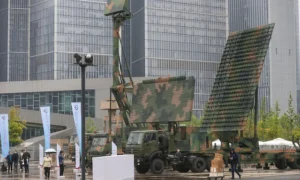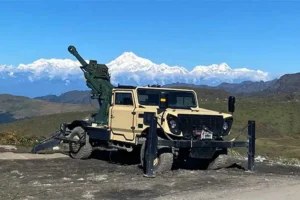Source : Tribune India
 |
| Pipe dream: The Chinese are seeking to replace the existing AL-31 F2 turbofan on the J-20 with the indigenous, more powerful WS-15. (PTI Photo) |
Gp Capt Murli Menon (Retd)
Defence analyst
While much has been written about the two armies’ capabilities amid the India-China standoff, a comparison between the air forces has been scarce. A recent article in Hong Kong-based South China Morning Post has raved about the touted ‘supermanoeuvring’ capabilities of the upgraded J-20B ‘Mighty Dragon’ Generation 5 interceptor/air superiority fighter, reportedly slated for mass production since last July.
The lessons learnt by the Chinese from the Indian Su-30MKI vs US F-15s during the Red Flag exercise of suboptimal use of ‘thrust vectoring’ or ‘supermanoeuvrability’ (which seeks to enable harsh defensive manoeuvring against aerial missile threats or even better, achieve advantageous weapon launch parameters during close combat with an adversary) have been used to refine their upgraded J-20B stealth platform. This, in itself, indicates a doctored proposition as the Indian Su-30MKIs allegedly wove circles around the Americans during those engagements! They had procured some thrust vector control (TVC) Su-35 aircraft from Russia, possibly to reverse-engineer the technology.
The images (albeit unclear) accompanying the South China Morning Post article appear to indicate changes in airframe-control surfaces for enhanced manoeuvrability and an enlarged spine fuel tank capacity. Now, whilst the Chinese are past masters at info/psychological operations/warfare campaign, especially against neighbours, suffice to say that everything mentioned in the article need not necessarily be gospel truth; sans any authentic kinetic or computer fly-off against established fighter technologies from the West and even India (such as the Su-30MKI or the impending Tejas 2 or Advanced Medium Combat Aircraft, AMCA), these comparisons would remain speculative.
The Chinese are seeking to replace the existing AL-31 F2 turbofan on the J-20 with the indigenous, more powerful WS-15 to achieve an enhanced thrust-to-weight ratio. But this will remain a pipe dream until the WS-15 indigenous manufacturing project gains fruition. But then, why should the Chinese be seeking supermanoeuvrability as a preferred option for the J-20B, if indeed the advantage of TVC is negated by the disadvantage of a rapidly decaying speed vector and consequent vulnerability to “follow-on” attacks by the adversary?
Quite clearly, the Chinese author praising the unique thrust vector capability of the J-20B does not understand if it is indeed a plus point in design or rather a handicap in close combat. The renowned vectoring in forward flight (or ‘VIFFing’ as colloquially known) had proved tremendously advantageous to the Royal Navy Harriers fighting Argentine fighter resistance during the Falklands War of 1982. So it does appear that the Chinese are hell-bent on achieving air superiority as an attribute for their air force in any future air war against the Americans over Taiwan. But the crux of the issue would be air combat training, a perennial weak area for the People’s Liberation Army Air Force.
Experience from past episodes in fighter engine manufacturing does not suggest dramatic capabilities with the Chinese aircraft manufacturing industry, regardless of their tendency to ‘steal’ technology from the West. In the earlier case of the FC-1 (later JF-17) programme, the plan was to use Russian RD-33 engines (same as those on our MiG-29s) till Russian President Vladimir Putin himself declared that the transfer of technology would not be made available to the Chinese.
So, it is doubtful that the Chinese would remain at the mercy of Russian technology for engines, lest the entire aircraft programme flounders. Engine manufacture, especially from the ‘raw material’ stage, is challenging and has been the bane for industries in China and India (our own sad story of the Kaveri engine is typical).
Another key hindrance, especially for high-altitude fighter operations, would be the tailoring of fuel-metering jets on the engines to prevent a ‘rich cut’, especially during start-up.
The Indian Air Force (IAF) learnt to adapt to this peculiar requirement whilst learning to maintain the MiG-23BNs, MiG-23MFs and MiG-29s at Leh and Thoise. Ahead, the IAF could also think of operating fighters from Daulat Beg Oldie (DBO). Our experience found that it is easier to operate western-technology aircraft from high altitudes such as Mirages and Hawker Hunters. So, would it be for the Rafales and perhaps the Tejas and the advanced medium combat aircraft down the line as our technicians are proficient in these tweaks? The Chinese have been doing limited J-10 operations periodically from their high-altitude air bases such as Hotan and Lhasa Gongga.
But operationally, these bases pose stringent load penalties. On the other hand, India has 25-odd airfields along the Himalayan border capable of launching air operations across the hilly terrain into the Chinese mainland. Therefore, high-tech fighter aircraft, such as the J-20B, need not necessarily do the job in terms of objectives, as their radar missile combination would also be compromised in the high terrain. Another important consideration would be the efficacy of ground attack and air defence weaponry.
Traditionally, Russian and Chinese missiles, more so the air-to-air ones, have not been proven in air combat, unlike the ones employed in various air operations since World War II and Vietnam War by the Americans and their NATO allies.
The Chengdu Aerospace Corporation hopes to roll out 200 J-20Bs in the next five years, an amazing one aircraft or so per month over four production lines, which is remarkable by any standard. The aircraft is meant to bridge the technology gap with the American F-35 and F-22 and a naval version using TVC is also supposedly slated. The older J-20As flew across the Taiwan straits last year during the standoff over Nancy Pelosi’s visit. In any case, the Chinese would not in the long term accept Russian engine technology for their J-20Bs.








